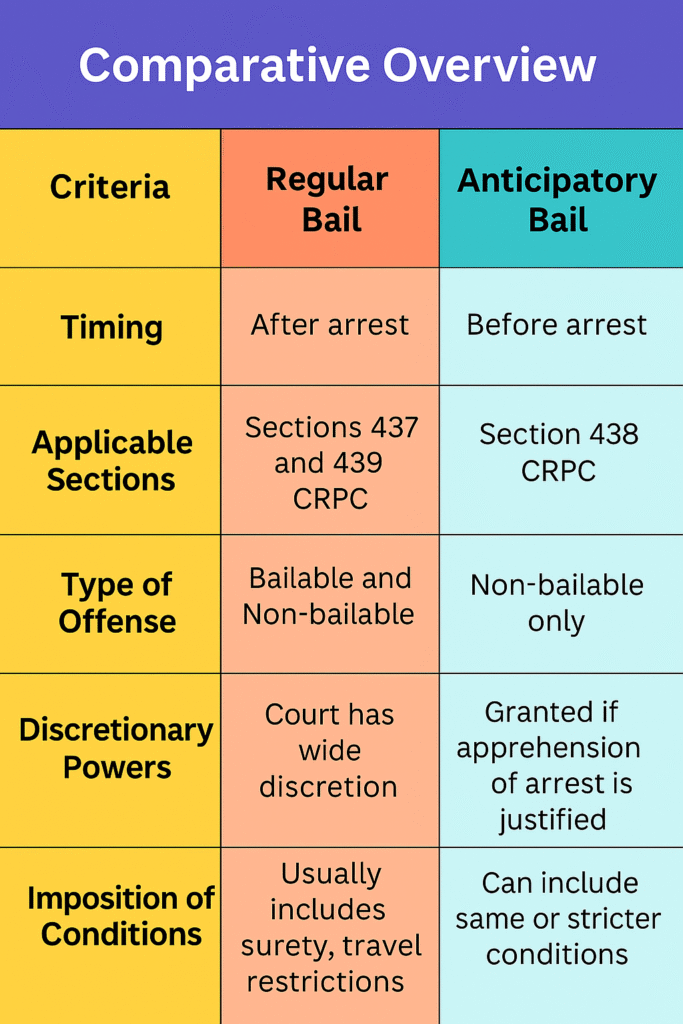Through Bail Laws in India, the criminal justice system prevents illegal and improper detainment of people who have not been proven guilty. Bail stands as an important legal concept that upholds the presumption of innocence before determining guilt in the Indian criminal justice system. Recent Indian laws have transformed Bail Laws in India through the substitution of the colonial-era Code of Criminal Procedure (CrPC), 1973, with Bharatiya Nagarik Suraksha Sanhita (BNSS), 2023. This article offers a detailed explanation of Indian bail practices through evaluations of bail types with emphasis on regular versus anticipatory methods and investigation of legal amendments that affect bail procedures.
Understanding Bail Laws in India
Civil bail functions in Indian law by enabling the temporary release of detained persons who promise to uphold court requirements when appearing for their hearings. During the legal process, individuals receive bail, which provides them freedom as well as protects them from wrongful incarceration that occurs before their conviction. The bail system of India functions to protect both the accused’s rights and the requirements of justice.
A prisoner granted bail receives freedom only through specified obligations. The intent behind bail is to protect essential rights of the accused, along with ensuring vital investigation movement and preventing escape attempts. The decision to permit or deny bail for a suspect depends on the unique details of each criminal case. Thus, judicial freedom stands as an indispensable component of Indian bail procedure.
Types of Bail in India
The Indian bail system contains different types of bail arrangements that establish particular legal terms during this process. These include:
Regular Bail
After an arrest, the courts provide regular bail for the arrested person. One can obtain this type of bail by applying Section 437 of the Magistrate’s Court or Section 439 of Sessions Court or High Court under the CrPC. Law enforcement authorities grant this type of bail to persons who face bailable, as well as non-bailable, criminal charges. Individuals who have undergone arrest procedures must obtain this specific type of bail.
Courts evaluate draft-specific legal evaluation criteria, including offense severity, together with individual runaway potential and evidence protection capacity, as well as public interest, to determine regular bail approvals.
Anticipatory Bail
Before being arrested, any person can submit applications for this type of bail. A person who expects arrest because of non-bailable crimes can ask for anticipatory bail through Section 438 of the CrPC. After approval of anticipatory bail, the individual can stay out of detention as they help the investigators with their work.
Every citizen must grasp the distinction between regular bail procedures and anticipatory bail entitlements. People request regular bail after arrest, whereas anticipatory bail acts as a preventive tool to prevent arrest when no legal basis exists for detention.
Interim Bail
The court issues this time-limited freedom to the defendant before deciding their regular or anticipatory bail petitions. A person under interim bail is prevented from being placed in custody until a court reaches its final determination.
Default Bail
Accused persons may obtain default bail according to CrPC Section 167(2) if the police delay beyond the time limit for charging (both 60 and 90 days based on different offenses). The right to a timely trial receives protection along with the guarantee against improper imprisonment through default bail laws.
Statutory Bail
Under this provision, the police must take responsibility for procedural delays to receive default bail, even if the case details do not support it. The default bail constitutes an essential safety mechanism throughout the bail procedures of Indian courts.
Legal Framework Governing the Bail Procedure in India
The Indian bail procedure receives legal governance from:
- The Criminal Procedure Code (CrPC), 1973, and now
- The Bharatiya Nagarik Suraksha Sanhita (BNSS), 2023
Bail procedures in India consist of multiple standard steps as follows:
- Accused parties must file their Bail Application through their counsel to the responsible court.
- During the bail process, both parties submit their evidence while making their case to the court.
- Medical staff specializing in treating transsexualism regularly assess the nature of crime alongside criminal background and potential public risks.
- If bail is approved by the court, it may require accused parties to present one of three options: providing a personal bond or assigning sureties, or handing over their passport or attending police check-ins at specified dates.
Under Bail Laws in India, the granting of bail stands as the primary principle, whereas jailing constituents of an exceptional situation. Bail availability for minor penalty offenses comes with a judicial mandate for liberal decisions during the application process.
Regular Bail vs Anticipatory Bail: Key Differences
The following table highlights the essential distinctions between standard bail procedures in India and anticipatory bail alternatives.

Every person participating in criminal cases must familiarize themselves with these distinctions because they define how bail operates in India.
Recent Legal Changes: BNSS 2023 and Impact on Bail Laws in India
Through its 2023 revision, the BNSS introduced revolutionary transformations to Bail Laws in India. Key reforms include:
- According to the BNSS definition system, bail bond stands together with bond as distinct concepts that further include bail as its own classification. These three terms remain ambiguous under the CrPC terms.
- Strict time limitations on investigation procedures set by the law have an effect on Indian bail protocols as they aim to decrease prolonged pre-arrest detentions.
- Through its bail guidelines specifically designed for women and children, BNSS strengthens security measures for the bail application process.
- The introduction of digital filing combined with digitized tracking serves two purposes: it increases process transparency while speeding up procedures through electronic bail application submission.
- When courts implement mandatory bail hearings, they must conduct these proceedings within set deadlines, which stops detainees from spending extended amounts of time in prison.
These reforms signal the evolution of an updated and responsible justice procedure for contemporary accountability needs.
Challenges Within the Indian Bail System
Three major problems affect the Bail Laws in India despite recent reforms being implemented.
- The accumulation of cases at courts brings an extended period between hearings and judgment announcements.
- Different courts show variable legal interpretations, due to which the law becomes hard to understand.
- A large portion of undertrial inmates face challenges because of their inability to secure appropriate legal help.
- Economic status determines bail release because defendants need assurance from financial backers, whose availability creates unequal access to justice for the people whose income is below the poverty threshold.
- Police officials exercise operational freedom in non-bailable criminal matters, so they can apply either way.
The Bail Laws in India will become more accepting of all individuals by improving legal assistance programs and making judicial decisions uniform, and evaluating bail requirements more easily understood.
Case Study: Arnesh Kumar v. State of Bihar (2014)
The Supreme Court made history with its decision to alter Bail Laws in India for offenses covered by seven years ‘ imprisonment. Such arrests need to be reasoned-based decisions while the police make them according to the court guidelines. For the enforcement of Sections 41 and 41A of the CrPC, police officers must prove why an arrest becomes necessary.
This ruling directly lowered the number of unnecessary arrests, which stopped legal process abuse from happening. Through this decision, the court worked to increase judicial bail by designating that courts should exercise more flexibility when granting bail. The case established itself as the principal authority for defining bail procedures that respect human rights protections throughout India.
Other Landmark Judgments
Judgments from various other cases in India have influenced the rules of bail through their decision-making process.
- Gudikanti Narasimhulu v. The Supreme Court declared through Public Prosecutor (1978) that release on bail remains the preferred principle over incarceration.
- Hussainara Khatoon v. Under State of Bihar (1979), the court established that bail denial constitutes a violation of Article 21 protecting life and personal liberty.
- Sanjay Chandra v. Economic crimes according to CBI present legal grounds that may not require bail denials (2011).
Judicial rulings have established the constitutional interpretation of bail principles alongside the legal role of preserving liberty as a fundamental right in India.
Importance of Legal Awareness
Knowledge about Bail Laws in India should be regarded as essential by both legal practitioners and ordinary citizens alike. Legal literacy programs need to offer education about standard bail procedures to people.
- People should learn the timing coupled with procedures to file an anticipatory bail petition.
- Their rights under the Indian bail system
- The differences in regular bail vs anticipatory bail
Denying people access to justice would be reduced through this move while also lowering instances of unjustified authority use.
Conclusion
Indian society has established Bail Laws in India which stand formally linked to the nation’s dedication to protecting freedom and delivering justice. Understanding the legal structure of the Indian bail system, along with its bail types and new changes implemented through BNSS 2023, has become vital as this system continues to develop. The combination of an educated population along with judicial system reforms will maintain fair, transparent procedures that give access to bail for everyone in India.
India will build an efficient justice-based Bail Laws in India that upholds personal freedom through the implementation of digital reforms and the understanding of regular bail differences from anticipatory bail.
FAQs for Bail in India
- 1. What is the difference between regular bail and anticipatory bail?
Regular bail is granted after arrest under Sections 437 and 439 CrPC, while anticipatory bail is granted before arrest under Section 438 CrPC.
- 2. Who can apply for anticipatory bail in India?
Any person who apprehends arrest in a non-bailable offense can apply for anticipatory bail under Section 438 CrPC.
- 3. Can anticipatory bail be granted for bailable offenses?
No, anticipatory bail is only applicable for non-bailable offenses.
- 4. What conditions can the court impose on regular bail?
Courts may impose conditions like surety bonds, travel restrictions, or regular appearances for regular bail under Section 437/439 CrPC.
- 5. Is it mandatory for the court to grant anticipatory bail?
No, anticipatory bail is discretionary. It is granted only if the court is satisfied that the apprehension of arrest is genuine.




Pingback: Kashmir Terror Attack 2025: Security Fallout and Global Reactions
Pingback: CLAT 2025 Results Under Judicial Review: Updates & Impact
Pingback: How to Get Free Legal Aid in India – Who is Eligible?
I’ve been browsing online more than 3 hours today, yet I never found any interesting article like yours. It’s pretty worth enough for me. Personally, if all site owners and bloggers made good content as you did, the web will be a lot more useful than ever before.